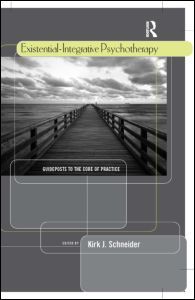Description
Existential-Integrative Psychotherapy
Guideposts to the Core of Practice
Coordinator: Schneider Kirk J.
Language: English
Subject for Existential-Integrative Psychotherapy:
Keywords
Existential Integrative Psychotherapy; approach; Existential Psychotherapy; james; Existential Integrative Approach; bugental; Chronic; psychology; Experiential Liberation; experiential; Existential Approach; liberation; EI Model; integration; Follow; martin; Young Man; buber; Drawing Back; therapists; Existential Psychology; LGB Person; Saybrook Institute; Feedback; James Bugental; Disengage; Wo; Holds; Feminist Therapy; LGB People; APA Presidential Task Force; MFT; Dialogical Therapists; Integrative Psychotherapy; Internalized Homophobia
Approximative price 181.39 €
Subject to availability at the publisher.
Add to cartPublication date: 08-2007
Support: Print on demand
Publication date: 11-2015
· 15.2x22.9 cm · Paperback
Description
/li>Contents
/li>Biography
/li>
Existential-Integrative Psychotherapy promises to be a landmark in the fields of psychotherapeutic theory and practice. A comprehensive revision of its predecessor, The Psychology of Existence, co-edited by Kirk Schneider and Rollo May, Existential-Integrative Psychotherapy combines clear and updated guidelines for practice with vivid and timely case vignettes. These vignettes feature the very latest in both mainstream and existential therapeutic integrative application, by the top innovators in the field. The book highlights several notable dimensions: a novel and comprehensive theory of integrative existential practice; a premium on mainstream integrations of existential theory as well as existential-humanistic integrations of mainstream theory; a focus on integrative mainstream as well as existential-humanistic practitioners, students, and theorists; a discussion of short-term and cognitive-behavioral existential-integrative strategies; a focus on ethnic and diagnostic diversity, from case studies of multicultural populations to vignettes on gender, sexuality, and power, and from contributions to the treatment of alcoholism to those elucidating religiosity, psychoses, and intersubjectivity.
Preface. Introduction: Existential-Integrative Psychotherapy: A New Era. Part I: From Segregation to Integration. Bassett-Short and Hammel, Existential Psychotherapy from Within the Training Process. Part II: Guideposts to an Existential-Integrative (EI) Approach. How the Chapter is Organized. Theory of the Existential-Integrative (EI) Approach. Therapy as Liberation Strategies/Consciousness as Liberation Levels. Constriction (Smallness) and Expansion (Greatness) as Omnipresent Horizons. Developmental View. Therapeutic Implications of the Theory. How to Discern Appropriate Liberation Strategies. The Offering of Nonexperiential Liberation. The Offering of Semi-Experiential Liberation. The Offering of Experiential Liberation. Presence: A Primary Nutrient. Smallness-Greatness "Clustering:" Keys to the Experiential Work. Invoking the Actual: Creatively Inspiring Presence. Vivifying and Confronting Resistance (Protections). Rediscovering Meaning and Awe. Summary of the EI Model. Appendices. Summary of the Four Stances of the Experiential Liberation Strategy. Ways the Stances Utilize Constrictive-Expansive Dynamics. Summary of EI Decision Points. Skill-Building Exercises: Suggestions for Instructors. I. Personal Exercises. II. Clinical Exercises. Notes. References. Part III: Case Studies of the EI Model. Section 1: EI Approaches to Multiculturalism. Comas-Diaz, Latino Psychospirituality. Rice, An African-American Perspective: The Case of Darrin. Alsup, Existentialism of Personalism: Case of a Native American Adolescent. Section 2: EI Perspectives on Gender, Power, and Sexuality. Brown, Feminist Therapy As A Meaning-Making Practice: Where There Is No Power, Where Is The Meaning? Monheit, A Lesbian and Gay Perspective: The Case of Marcia. Serlin, Women and the Midlife Crises: The Anne Sexton Complex. Section 3: Innovations in Short-Term EI Practices. Bugental, Preliminary Sketches for a Short-Term Existential-Humanistic Therapy. Galvin, Brief Encounters with Chinese Clients: The Case of Peter. Section 4: EI Mediation of Addiction: Alcoholism. Ballinger, Matano, and Amantea, A Perspective on Alcoholism: The Case of Mr P. Section 5: Spiritual and Religious Issues From an EI Perspective. Hoffman, An Existential-Integrative Approach to Spiritual and Religious Clients. Section 6: Cognitive-Behavioral Innovations of EI Practice. Wolfe, Existential Issues in Anxiety Disorders and Their Treatment. Buntin and Hayes, Language and Meaning: Acceptance and Commitment Therapy and the EI Model. Section 7: EI Approaches to Severe States. Dorman, Dante’s Cure: Schizophrenia and the Two-Person Journey. Mendelowitz, Meditations on Dissociation: Kristina and the Enigmatic Self. Section 8: EI Emphases on the Intersubjective. Portnoy, Relatedness: Where Existential and Psychoanalytic Approaches Converge. Stolorow, Autobiographical and Theoretical Reflections on the "Ontological Unconscious". Fosha, Transformance, Recognition of Self by Self, and Effective Action. Section 9: EI Child Therapy. Curtin, The Inner Sense of the Child: The Case of Joey. Section 10: EI Encounters with Death and Dying. Bugental, Swimming Together In a Sea Of Loss: A Group Process for Elders. Greening, Reflections on the Depressed and Dying: The Case of Carol. Summary and Conclusion.
Kirk J. Schneider, Ph.D., is a licensed psychologist and leading spokesperson for contemporary humanistic psychology. He is an adjunct faculty member at Saybrook Graduate School, the California Institute of Integral Studies, and the Institute for Transpersonal Psychology. He is also a Fellow of the American Psychological Association and the editor of Journal of Humanistic Psychology. He is a past president, current vice-president, and founding member of the Existential-Humanistic Institute of San Francisco.




